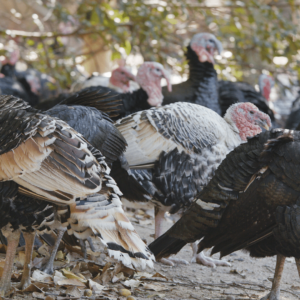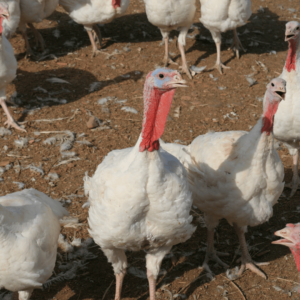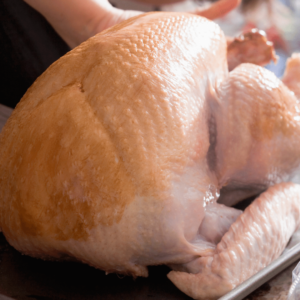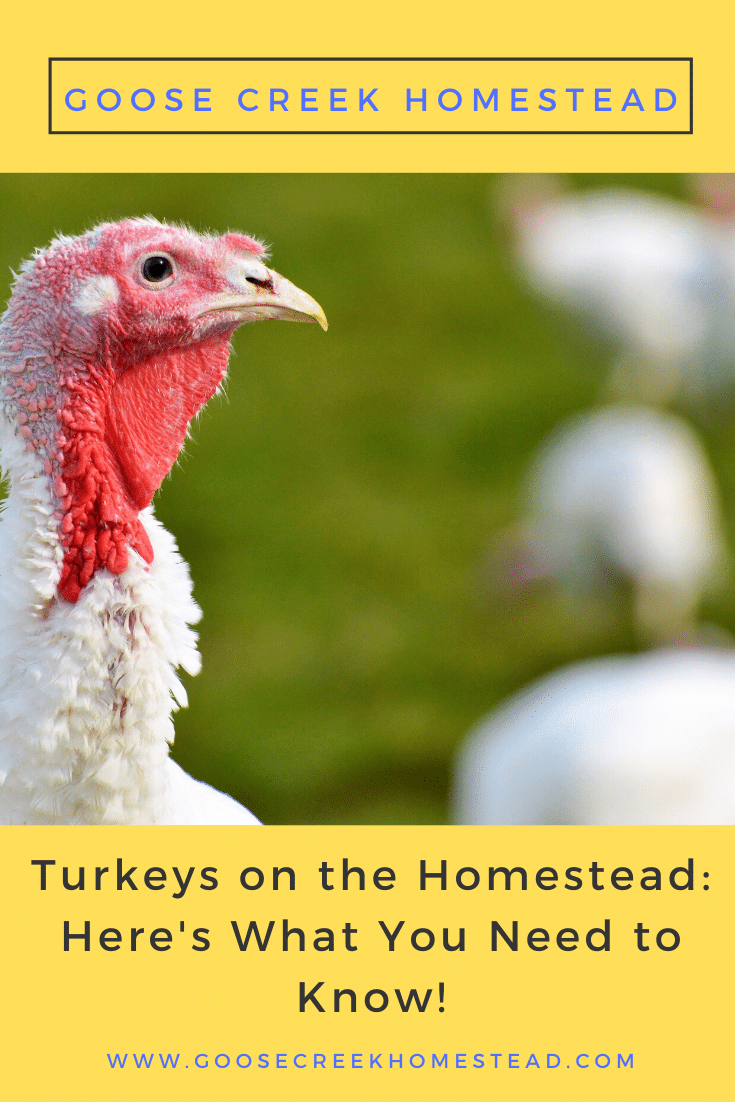Turkeys on the homestead are a great source of food for the family. They’re a joy to have around the farm, too. Here’s what you need to know to get started!
We’ve had turkeys on the homestead off and on over the years, and I’ve never regretted it. Turkeys have so much personality! They are playful and busy, very much like chickens. Many of our turkeys have been very affectionate and enjoyed being petted and even held. In fact, some of them also followed us around the yard like puppies. It’s actually kind of hard not to fall in love with them.
Personality aside, turkeys are generally raised on the homestead for their delicious meat. However, they are also great for pest control; one of their favorite foods is the dreaded tomato hornworm! Here are the most important things you need to know about becoming more self-sufficient by raising turkeys on the homestead.

Turkey Breeds
There are lots of turkey breeds to choose from. My personal favorite is the heritage breed, Midget White. They stay relatively small, which is perfect for our little family. The smaller size means they don’t eat as much, which also makes them more economical. I also like the fact that their pin feathers are white, so they have a nice clean carcass, which looks nicer for roasting.
If you have a large family and want a larger bird, consider the Bourbon Red. Bourbon Reds are popular on small farms because they are excellent foragers with a reasonably large breast. Their pin feathers are light-colored, so there aren’t any dark marks from the feathers on the carcass at roasting time. They are known for having rich, delicious meat.
Other popular breeds include the Broad Breasted White, the Narragansett, and the Broad Breasted Bronze. Check around to see what breeds are available in your area. Speaking to local farmers who have raised turkeys in your climate can give you some valuable insight into which breeds will do best in your area.

What You Need to Get Started with Turkeys on the Homestead
As you might guess, you will need pretty much the same equipment for your turkey poults as you do for chicks. Turkeys are a bit more delicate than chicks though, and they require some extra care. Don’t let them get wet, cold, or overheated. Any of these situations could lead to death or near-death very quickly.
You’ll want to feed them 28% protein turkey starter until they are about eight weeks old. Prepare yourself because baby turkeys eat a lot more than baby chicks! Regular chick feeders work great for turkeys, but you’ll probably want to have more than one in the brooder because they go through the food so fast.
As far as water goes, stick to the little chick waterers with small openings. They will empty them fast so you may need a few. In my experience though, baby turkeys will soak themselves if they have waterers with large openings, and since they can be delicate, a wet baby turkey is not a good situation. Sometimes you will need to add some shiny pennies or marbles to their waterers to get them interested so they’ll drink.
They will also need a heat lamp. I keep it at about 18 inches high until they’re about 5 days old. After that, it should be raised an inch or so every five days. Make sure there’s plenty of room for everyone to get under the heat lamp. Otherwise, they will pile up on top of each other. If they pile, you could end up with some crushed or smothered poults at the bottom of the pile.
You can take the heat lamp away once they’re fully feathered. However, baby turkeys seem to be more delicate than chicks. I tend to keep them in the brooder for a week or two after they’re feathered, and definitely keep them away from larger birds until they can fend for themselves.

Meeting the Needs of Your Young Turkeys
Our turkeys have always mingled with the rest of the farm animals once they’re big enough. They often roost with the chickens or sometimes in the main barn. However, there is a disease called Blackhead that is supposed to be a problem when chickens and turkeys are kept together. We’ve never had any issues with it, and I’ve never known anyone who has. Still, it is worth mentioning that many experts recommend not even raising turkeys on the same farm with other poultry. You should do your own research before you decide to let your turkeys mingle with the chickens.
The young turkeys can be switched over to turkey grower that is about 24% protein when they are eight weeks old. Then at six months, you can switch them to 16% protein pellets or crumbles. When they reach eight weeks of age, you should be able to tell the toms from the hens because they will walk around with their wings and tail feathers fanned out. The toms will also grow faster than the hens, and they will start to gobble when they are around this age as well.
Turkeys don’t do well with temperature extremes. Be sure to provide plenty of shade and fresh water in the summer. Turkeys are very vulnerable to the heat. The same goes for winter; they’ll need a bit more protection from the cold than your chickens do.
Turkeys can also do great on pasture because they love to forage. A movable electric net fence with a portable shelter would work great, as long as they had plenty of protection from the elements. A modified chicken tractor type enclosure would also be great, especially if you were just raising a few turkeys at a time. If you can give them plenty of access to fresh forage, it will cut down on your feed bill significantly, making them much more economical to raise.

When to Butcher Your Turkeys
Generally, heritage breed turkeys are butchered when they are anywhere from 12 to 24 weeks old. If you’re raising one of the new, heavier breeds, they’ll probably be ready to go at somewhere between 12 and 18 weeks. Often, hens are processed younger as broilers or fryers. The toms are left to grow longer into nice big roasters. However, the age of processing will vary somewhat depending on the breed and diet of your turkeys.
Final Thoughts
Turkeys on the homestead are a great source of food for the family, and they’re a joy to have around the farm, as well. Let them free range and they’ll help out with pest control, too. They’re a fantastic livestock choice for homesteads of all sizes!



